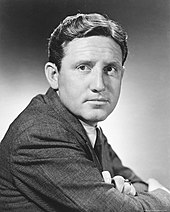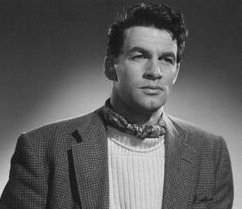
SPENCER TRACY (1900-67)
Spencer Tracy was already forty-one years old when America’s war began on 7 December 1941. He was also married and had previously served in the Navy as a 17 year-old in the Great War. He was still at the Norfolk Navy Yard in Virginia when the Armistice ended hostilities in that conflict, but it was scarcely the boy’s fault that he never got to see action. He, therefore, had no reason to feel guilty about not being in uniform in World War Two. None whatsoever. Sadly, however, he was constantly heckled by servicemen who accused him of being a draft dodger. It was grossly unfair but, of course, he was not alone in that regard. One night at a boxing tournament at the Hollywood Legion Stadium, the heckling was so bad that he had to leave the stadium before the main bout. Later, he attempted a few USO tours but the long dreary trips bored him. After being grounded by bad weather in Seattle he simply quit and returned home, his USO career unceremoniously over.

Tracy, Irene Dunne & Van Johnson (1943)
During the war years he made three movies that were war-based. The first of these was A Guy Named Joe (1943) with Irene Dunne, and it became his highest-grossing picture to date. The Seventh Cross (1944) was about an escape from a Nazi concentration camp; the third being an aviation film titled Thirty Seconds over Tokyo (1944). These last two productions saw Tracy end the war as MGM’s biggest money-making star of 1944. Many of his contemporaries considered him to be the best movie actor ever, and it is difficult to argue with that sentiment, especially when we take into account his constant battle against alcoholism and diabetes, not to mention his total lack of stage training or experience. As an actor he was unique.
On 10 June 1967, seventeen days after completing his final film, Guess Who’s Coming to Dinner, Tracy awakened at 3.00am in his Beverly Hills apartment and went to the kitchen to make a cup of tea. His companion of more than twenty years, actress Katharine Hepburn, wrote in her autobiography how she followed him to the kitchen. ‘Just as I was about to give [the door] a push, there was the sound of a cup smashing to the floor – then clump – a loud clump.’ She found the love of her life lying dead from a heart attack. He was sixty-seven. ‘He looked so happy to be done with living’, she recalled, ‘which for all his accomplishments had been a frightful burden for him.’ In typical Hollywood fashion in those days, MGM publicist and ‘fixer’ Howard Strickling told the media that the deceased had been alone when he died and had been found by his house-keeper!

BILL TRAVERS (1922-94)
The 6’4” (1.94m) Bill Travers was born in Sunderland, County Durham, England in 1922 as William Linden-Travers. He would acquire a measure of screen immortality acting alongside his lovely second wife, British actress Virginia McKenna, as they portrayed real life couple George and Joy Adamson in the enormously popular 1966 film Born Free, a story that focused on the raising of Elsa, an orphaned lion cub, on the Adamson property in Kenya. Bill and Virginia would ultimately found the Born Free Foundation in 1991.

Bill during WW2
Back in 1940, Bill enlisted in the British Army as an eighteen year-old private a few months after war broke out, and was sent out to India where, on 9 July 1942, he was commissioned as a 2nd lieutenant in the Indian Army. Serving in the Long Range Penetration Brigade 4th Battalion 9th Gurkha Rifles in Burma, he was attached to Orde Wingate’s staff, where he came to know Brigade Major John Masters. Travers would later star in Bhowani Junction (1956), the screenplay for which would, in fact, be written by Masters.
Lieutenant Travers contracted malaria while deep behind Japanese lines and volunteered to be left behind in a native Burmese village, rather than slow down his comrades. To avoid capture and almost certain death, he disguised himself as a Chinese national and later walked hundreds of miles through jungle territory until he reached an Allied position. Promoted to the rank of major in 1945, he joined Force 136 Special Operations Executive (SOE) and was parachuted into Malaya where he became responsible for training and making tactical decisions with the main resistance movement, the communist-led Malayan People’s Anti-Japanese Army (MPAJA).

Bill & wife Virginia McKenna in Born Free (1966)
At the end of the war he was one of the first Allied operatives to enter the Japanese city of Hiroshima after the dropping of the atomic bomb, and wrote in his diary of his profound horror at the devastation and loss of life. In November 1946, he was awarded an MBE ‘in recognition of gallant and distinguished service whilst engaged in Special Operations in South-East Asia.’ Major Travers left the Army in 1947. His marriage to Virginia was in its 37th year when he passed away in his sleep in 1992 aged 72. The couple had four children. Bill sired another with his first wife.

FORREST TUCKER (1919-86)
When the name of Forrest Tucker is mentioned to a product of the Baby Boomer generation (like me), fans naturally think of him playing Sgt. O’Rourke in the wonderful sixties TV series F Troop. He was also memorable in the John Wayne war flick Sands of Iwo Jima (1949) as the GI who stops off to grab a cup of coffee after being sent back to the rear by his buddies to get fresh water and ammunition. By the end of 1942, Tucker had appeared in no fewer than fourteen movies since his debut in The Westerner (1940), but he put his screen career on hold for the duration and enlisted in the United States Army – for the second time. He had lied about his age and enlisted once before prior to 1940. He was soon discovered to be under-age and promptly discharged. With the war in full swing by 1942, however, he was commissioned as a 2nd lieutenant and served in that capacity until his discharge at war’s end three years later.

As Sgt. O’Rourke in F Troop
Although he did much of his acting in Poverty Row productions (even Sands of Iwo Jima was churned out by Republic), Tucker demonstrated his versatility on several occasions. This was never more evident than when he played Beauregard Burnside to Rosalind Russell’s Auntie Mame in 1958. Then, beginning in 1962, for all of five years and 2,008 performances he played the lead in a touring production of The Music Man. And he was terrific. ‘When we folded up The Music Man after touring it for four years, I thought I would never have such fun again’, he recalled. ‘I figured it was all downhill the rest of my life. I was wrong.’ The iconic western spoof was to follow and through it he achieved a measure of genuine immortality. Lung cancer and emphysema took the 6’4” actor at sixty-seven.


Leave a Reply